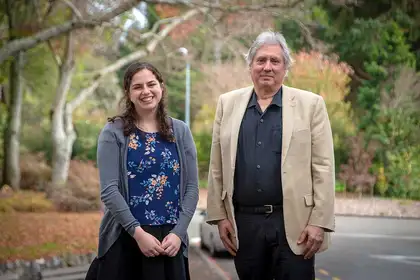
Professor Steven Gorelick and his PhD student Abigail Burnbaum.
Massey University and the Ministry for the Environment hosted a world-leading freshwater expert last month to explain and explore a modelling approach that might help New Zealand understand and manage its water resources.
Stanford University’s Professor Steve Gorelick leads the Global Freshwater Initiative, a multidisciplinary team made up of experts from hydrology to sociology, who examine the long-term viability of freshwater supplies in countries around the world, like Jordan one of the world’s most water-poor countries.
Their work in these countries is focused on developing freshwater hydro-economic policy evaluation models that build a picture of freshwater resources and its many variables, such as surface water supply, groundwater supply, agricultural demand, regulations, drought, and social behaviour of people using water.
The team focus on water vulnerability rather than sustainability.
“Unsustainable systems are easy to define but it is hard to know when a system is sustainable,” says Professor Gorelick. “We look at actions that focus on reducing the vulnerability of a freshwater system, but also trends that effect it, and by exploring future scenarios through an integrated model, we provide a greater understanding of which management practices will have the greatest impacts.”
Professor Gorelick, along with his PhD student Abigail Birnbaum, met with Massey University academics, Ministry officials, regional councils, and researchers from a number of universities, agencies and Crown research Institutes, as well as taking field visits to water projects in the Wairarapa and Manawatū.
They also got a chance to meet representatives from Manawatū iwi, Rangitane and Massey academics who are working on the ground breaking He Tātai Whenua: A Te Ao Māori landscape classification project in the Manawatū River catchment area, incorporating Māori knowledge into scientific data systems.
Massey’s Assistant Vice-Chancellor Māori and Pasifika, Dr Charlotte Severne, who met Professor Gorelick at Stanford, says his visit is an important opportunity for New Zealand to gain world leading insights to water resource solutions. “I’ve seen how valuable his modelling has been for other countries and I think it will help us negotiate the many factors involved in our water management including the needs of Māori, the environment and industry.”
He says the visit was not to implement the model, but to explore the opportunities it may give the country.
“We are here to have a look at the freshwater issues for people and the environment here, determine the priorities, look at some of the national and regional activities and see if there is potential for New Zealand to explore its future using this integrated modelling approach. For policy makers, the model allows them to explore the outcomes of their actions under many different scenarios, some out of their control, without actually having to implement them.
“It’s an uphill climb no matter where you are, but from what I have seen here, I think the approach is potentially valuable to New Zealand. You have freshwater vulnerability, you have the same technology as we have, you have the technologies to monitor and to measure land use and water resources.”
The visit came about through a discussion in a Te Hono bootcamp at Stanford University involving senior government and business representatives including Maori agribusiness, and the invitation came from the Secretary for the Environment, Vicky Robertson, and the Vice Chancellors of Massey and Lincoln Universities.
Te Hono comes from a greater concept: Hono Tangata, Hono Whenua, Hono ki te ao – strengthening relationships by linking to the land and connecting to the world. It is business led and government partnered group of New Zealand agribusiness leaders who are exploring new ways of thinking and doing things.